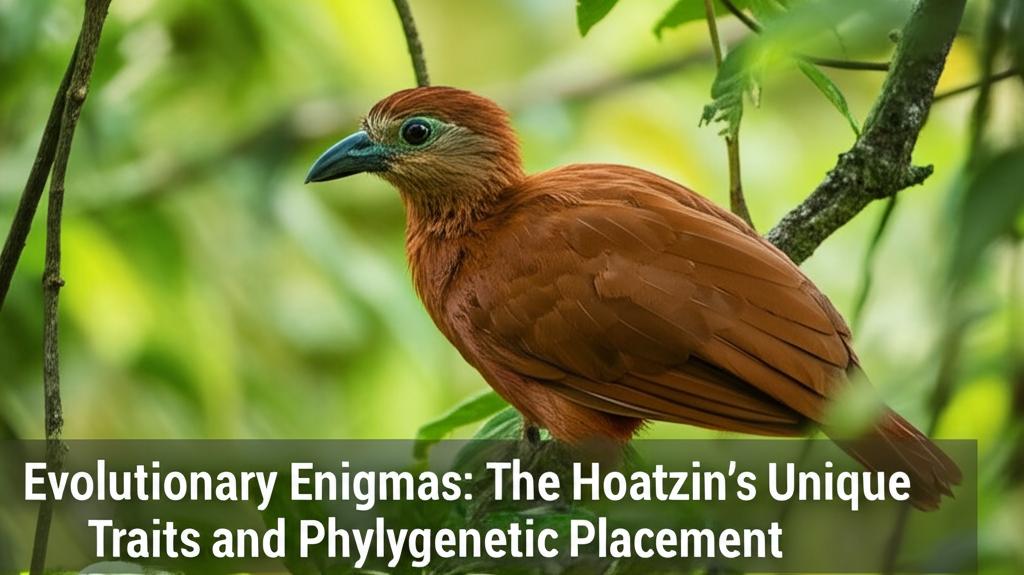The Hoatzin (Opisthocomus hoazin), a bird native to the swamps and riparian forests of the Amazon and Orinoco basins in South America, presents a fascinating case study in evolutionary biology. Its array of unusual characteristics has long puzzled scientists, leading to ongoing debate about its precise placement within the avian family tree.
Unique Traits of the Hoatzin:- Folivorous Diet and Ruminant-like Digestion: Perhaps the Hoatzin's most remarkable trait is its diet, which consists almost exclusively of leaves. To process this fibrous material, the Hoatzin has evolved a digestive system unique among birds, featuring a large, multi-chambered crop and lower esophagus where microbial fermentation takes place. This process, similar to that seen in ruminant mammals like cows, allows the bird to break down cellulose and extract nutrients from leaves. This specialized digestion is highly efficient but results in a pungent, manure-like odor, earning the Hoatzin the nickname "stinkbird." This strong smell also serves as a natural defense mechanism, deterring predators. The enlarged digestive system, however, makes the Hoatzin a clumsy and reluctant flier.
- Clawed Wings in Chicks: Hoatzin hatchlings possess claws on two of their wing digits. This seemingly primitive trait, reminiscent of the ancient bird Archaeopteryx, allows the young birds to clamber through dense vegetation and climb back to their nests if they fall or need to escape predators by dropping into the water below. These claws typically disappear as the birds mature. While some initially saw this as evidence of a direct link to ancient birds, modern researchers largely consider it a more recent adaptation to their specific arboreal and waterside habitat.
- Distinctive Appearance: The Hoatzin is a pheasant-sized bird with a striking appearance. It sports a small head with an unfeathered blue face, maroon eyes, and a prominent, spiky rufous crest. Its plumage is generally chestnut or sooty-brown, often with buff-edged wing coverts and a long tail tipped with a broad whitish or buff band.
- Social Behavior and Vocalizations: Hoatzins are social birds, often found in small family groups. They are known for their loud, guttural calls.
The Hoatzin's unique combination of traits has made its classification a long-standing enigma. It is the sole living species in its family, Opisthocomidae, and order, Opisthocomiformes, highlighting its distinctiveness.
Throughout history, it has been tentatively allied with various bird groups, including gamebirds (Galliformes), cuckoos (Cuculiformes), turacos (Musophagiformes), rails, bustards, doves, and mousebirds.
- Early Genetic Studies and the "Ancient Lineage" Hypothesis: A significant genetic study published in Nature in 2015 suggested that the Hoatzin is the last surviving member of an avian lineage that diverged from other birds around 64 million years ago, shortly after the mass extinction event that wiped out the non-avian dinosaurs. This supported the idea of the Hoatzin as an evolutionary "orphan" representing a very old branch of the bird family tree.
- Challenging the "Ancient" Narrative: However, more recent research continues to refine our understanding. A 2024 study in PNAS, which mapped the genomes of over 360 bird species, suggested that the Hoatzin's evolutionary history might not be as ancient as previously believed, or at least, that its early divergence is shared with many other modern bird orders, making it not uniquely "primitive" in that sense. This study still struggled to place the Hoatzin definitively, categorizing it as an "orphan group" without clear close relatives among major bird families.
- Fossil Record and Biogeography: The fossil record adds another layer to the mystery. Fossils attributed to Hoatzin ancestors have been found not only in South America but also in Africa and Europe, with some European fossils dating back as far as 34 million years (Eocene Epoch). This suggests an Old World origin for the group, with a later dispersal to South America, possibly across the Atlantic on rafts of vegetation.
Despite numerous morphological and genetic studies, the Hoatzin's precise phylogenetic position remains one of the most intriguing unresolved questions in avian systematics. While some studies have pointed to potential relationships with turacos (supported by some osteological and behavioral similarities, including clawed wings in turaco chicks) or a clade including cranes and plovers, no single placement has garnered universal consensus with robust, consistent support across all datasets and analytical methods.
The Hoatzin continues to be a subject of active research. Its unique adaptations, particularly its digestive system and the developmental curiosity of its clawed wings, offer valuable insights into avian evolution, adaptation, and the diverse strategies life employs to thrive in specific ecological niches. This "evolutionary enigma" serves as a potent reminder of the complexity of life's history and the ongoing journey of scientific discovery in unraveling it.

